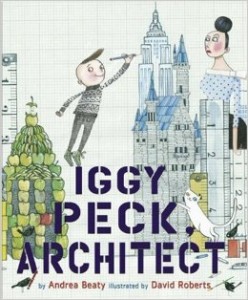Collaboration with the art teacher, the librarian and classroom teacher are necessary for the unit of “Conception To Production.” The unit requires scaffolding concepts from the art teacher, the librarian and the classroom teacher.
Introduction:
Architecture is such a fun way to interact with the world and introduce the concept of balance and motion and 3D printing. With each building Iggy constructs, the students will formulate connections, text-to-self, text-to-world, and better understand the concept of building 3D via the elements Iggy used in construction (physical and stylistic), how the elements integrate and what influences design.
Read: Iggy Peck Architect by Andrea Beaty illustrated by David Roberts.

Use the video below to support the visual learners in your classroom or as an opportunity for students to revisit the story independently.
Students will understand the difference between 2D and 3D art. Students will learn the difference between shape vs. form and view various samples of 3D art. Students will practice sketching forms such as cubes, spheres, cylinders, cones, etc…
Students will explore the concept of creating form with a variety of materials such as blocks, paper, paper folding, etc
How do balance and motion connect to art? Viewing mobiles created by sculptor Alexander Calder, students learn mobiles, experiment with balancing levers, and equilibrium. Students will learn about the function and form of levers. Students will gain a deeper understanding of the function of levers by viewing the mobiles created by sculptor Alexander Calder. They will build a simplified 3D printed mobile, experiment with balancing levers and discuss finding equilibrium.
Resources:
- Photobiograghy of Alex Calder
- Worksheet: Lever Worksheet 1
- Worksheet: Lever Worksheet 2
- Worksheet: Lever Worksheet 2 Answer Key
Below are two videos that introduce Alx Calder and his work with “Forces and Motion. “
PBL:
Ms. Carr’s son, Hudson, is 5 months old and is mesmerized by mobiles. A mobile is something capable of moving or being moved readily. Because Hudson loves mobiles so much, Ms. Carr’s husband decided there should be a mobile in every room! Your task is design a class mobile for Hudson. Watch the video below to see how much Hudson enjoys his mobile. What will your mobile look like?
We will first draw our design on graph paper and then we will recreate our design using Tinkercad. Tinkercad is an easy-to-use tool for creating digital designs that are ready to be 3D printed into physical objects. Users are guided through the 3D design process through ‘Lessons’, which teach the basics before moving on to more complex modeling techniques.This is a tutorial video that teaches you the basic functions of Tinkercad, a 3D design tool.
What is 3D printing? How Does It Work?
- How 3D printing supports STEM learning by collecting data through a hands-on approach that impacts design decisions
- How 3D printing allows for increased student engagement by supporting core content material in non-core classes
Reflection For Building:
1. Were you able to balance your mobile?
If yes, what objects were in each cup? If no, what made it difficult to balance?
2. Which object is the heaviest? Which is the lightest?
3. What happens if you shorten one of the strings attached to the paper cup?
4. What happens if you move the fulcrum (string attached to ruler) left or right?
5. How did your mobile demonstrate kinetic or potential energy?

